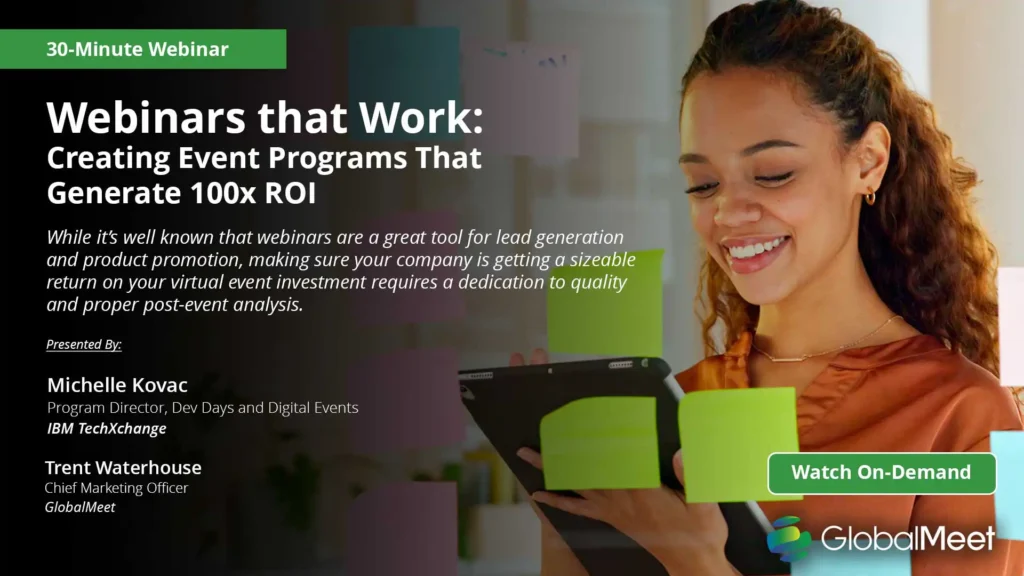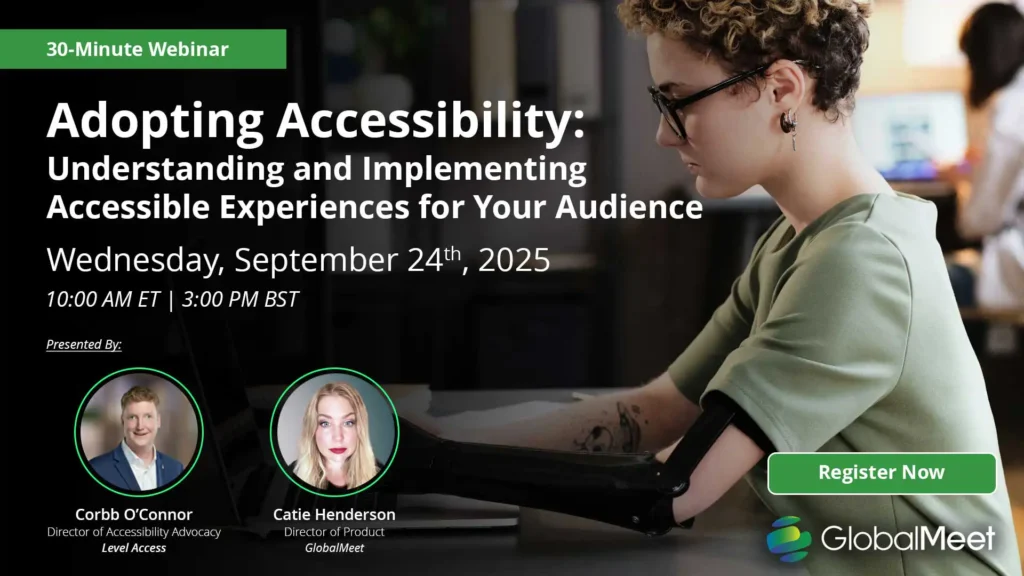
How to Host a Virtual Conference: A Strategic Guide to Success
- by GlobalMeet Blog Team
- ,
In recent years, the virtual conference has transformed from a necessity to a strategic staple for organizations worldwide. Whether you’re looking to build thought leadership, launch a product, or nurture leads, a well-executed virtual event can be as impactful — if not more so — than it’s in-person counterpart. But success doesn’t happen by accident. It requires deliberate planning, the right event technology, and a comprehensive virtual event strategy.
Choosing the Right Platform for a Smooth Virtual Experience
No matter the quality of the content, a virtual conference is only as good as the user experience it delivers, and the foundation of any successful virtual event is the platform you choose. A good platform should boast integrated features to facilitate an engaging, and interactive experience, with a technology stack that aligns with the goals, size, and format of your event.
State-of-the-art virtual event platforms offer robust feature sets that can be customized in line with your priorities. Identify your ‘must haves’ — such as hybrid capabilities or advanced analytics tools — and keep them in mind when selecting the right platform for you.
Scalability
You never know what’s going to happen in the run up to an event, and your platform needs to be as dynamic and flexible as you are. Before deciding on a platform assess if it can handle your expected number of attendees without compromising performance or audio / video quality, and ensure that it can rapidly scale with you if that number changes last minute.
Customization
In a world when brand recognition is everything, it’s vital that your chosen platform can be customized to meet your brand guidelines and requirements. Look for custom options for branding, slides, layouts, and content organization to better showcase your message.
Integrations
Good data can make or break post event analysis. Ensure your platform can connect with your chosen CRM system, allowing you to access high-tech marketing tools and simple registration systems for smooth administration behind the scenes.
Accessibility
Accessibility is no longer an optional extra. A good virtual event platform should be WCAG compliant, with captioning, screen readers, language translation, alt text, and color and contrast customization options. Plus, it should scale to work on a range of devices and connection speeds so that nobody is left in the dark.
Security
Information security should never be overlooked by you, or your chosen platform. Choose a virtual conference platform that was built with compliance standards in mind, featuring email specific access, password protections, and login authentication so that you never have to worry about your data being compromised.
Planning the Conference Agenda
A compelling agenda is the heart of your virtual event strategy. Unlike in-person events, virtual audiences are more prone to distraction, so keeping content concise, diverse and value-driven is key.
Balance Live and On Demand Content
Exclusive or time limited live sessions promote urgency, which can increase both attendance and engagement. When paired with on-demand content for increased flexibility and easier scheduling, you can create a dynamic virtual conference that suits broad audiences.
Segment the Day
Evidence suggests that in the digital era attention spans are getting shorter every year. Therefore, it’s important to consider your audience and their attention when planning the virtual day. Utilizing shorter sessions of around 45 minutes, followed by breaks to reduce screen fatigue, creates a balance that allows your attendees to fully engage.
Consider Time Zones
With more audiences being global than ever before, it’s important to ensure that attendees around the world have the same access as those in the host city. Stagger live sessions to allow more attendance, and offer replays of the most important information so that nobody is left in the dark.
Ensure Variety
The last thing any virtual conference attendee wants is to be bored whilst watching the same content format over and over. Mixing content formats with keynotes, panels, Q&A chats, product demos, and networking keeps the engagement and energy high, all day.
Identifying the Ideal Virtual Conference Content
Each session type should have a clear purpose and format, and how you approach them will have a big impact on the success of your virtual conference.
Keynotes
- Set the tone for the event
- Choose influential speakers or industry leaders
- Use storytelling and high-impact visuals to captivate attendees
Breakouts
- Keep them small and focused
- Use moderators to guide discussion and enable participation
- Enable live Q&A and interactive tools to deepen engagement
Panels
- Limit number of speakers to avoid crosstalk
- Prepare panelists in advance with discussion points
- Ensure everyone is aware of timings to avoid overrunning
Engaging Attendees
One of the biggest challenges facing the virtual events industry is combatting attendee passivity. When attention is so vital, it’s key to weave engagement into every single element.
Live Polling
Live polls allow you to gather real-time audience opinions, so you know how the sessions are going and where last-minute changes might need to be made. They are also great tools for sparking meaningful discussions in smaller panels and sessions.
Gamification
Award points for participation, or answering quiz questions, offering reward for those who complete the most engagement activities to create a buzz and keep everyone onboard.
Virtual Networking
Down let downtime become disengagement time. Between sessions allow attendees to virtually meet in topic-based breakout rooms, facilitating crucial networking opportunities while keeping the energy up.
Audience Chat
With a strong moderator to field questions and ensure that things stay on track, encouraging audience chat in appropriate sessions is a great way to keep conversations flowing and drive ongoing participation.
Technical Considerations
Don’t let technical glitches derail your virtual conference. Pre-event testing and live support are essential to ensure a smooth broadcast.
- Conduct dry runs and technical rehearsals with all speakers and moderators, so there are no surprises on event day.
- Check bandwidth requirements and ensure that your platform and speakers both have stable connections.
- Have a backup plan with pre-recorded items and elements in case of a presenter suddenly cannot participate.
- Offer technical support and provide attendees with troubleshooting and FAQs both before and during the virtual conference.
Managed Events
A professionally managed virtual event service might seem like a budget cost that you could easily save. However, with backstage production support, speaker preparation and onboarding, real time moderation and monitoring, and expert advice whenever you need it, that initial cost could remove significant technical difficulty. With a good managed events team, you could increase brand reputation and ROI, delivering flawless events every time.
Measuring Success
After your virtual conference ends, the real work begins. Measuring event performance ensures that your events drive tangible results, with the data you collect informing future virtual event strategies and driving continuous improvement.
Registration rate vs Overall attendance rate
Not only does this tell you how many attendees you had, but careful analysis could help you to identify trends in those who don’t attend, showing you which areas to target in future marketing.
Session Attendance
By tracking who attends each session, and for how long, you can evaluate the effectiveness of your session topics and speakers so you know what to adapt for future events.
Engagement Metrics and Feedback Scores
Data on poll responses, chat messages and questions, and visits to each session can help build a picture of your audience, their opinions, and what will make them more likely to return. Combined with survey feedback scores to gauge overall satisfaction, these metrics are fundamental to continuous improvement.
Platforms with built-in analytics tools make it easier than ever to create dashboards and reports after every event. This data not only helps you improve, but provides valuable insights for stakeholders and customers alike.
Conclusion
Hosting a virtual conference is a great opportunity to amplify your brand, connect with your audience, and create meaningful experiences without the limitations of physical space. But success comes from more than just good content; it requires the right event technology, thoughtful agenda design, and a comprehensive engagement strategy.
From choosing the right platform, to analyzing post event performance, every step plays a role in creating a virtual event that delivers value. By investing time and planning into your virtual conference, you can strive for impact, not just attendance.


